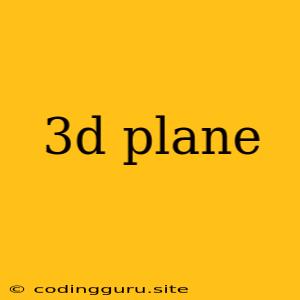Understanding 3D Planes: A Guide to the Foundation of 3D Graphics
In the realm of 3D graphics and computer-aided design (CAD), the concept of a 3D plane is fundamental. It represents a flat, two-dimensional surface that exists within a three-dimensional space. While it may seem simple, understanding 3D planes is crucial for creating realistic and complex 3D models, animations, and simulations. This article will delve into the world of 3D planes, exploring their definition, representation, and applications.
What is a 3D Plane?
A 3D plane is a flat surface that extends infinitely in two directions. Imagine a sheet of paper extending without bounds – that's essentially a 3D plane. It's characterized by its normal vector, which is a vector perpendicular to the plane, and a point that lies on the plane.
How to Define a 3D Plane?
There are several ways to define a 3D plane, each offering a different perspective and method of representation:
- Point and Normal Vector: This is the most common method. You need a point that lies on the plane and a normal vector that is perpendicular to the plane. The normal vector defines the orientation of the plane.
- Three Points: Given three non-collinear points, you can define a unique plane passing through them.
- Equation: A 3D plane can be represented by a linear equation of the form Ax + By + Cz + D = 0, where A, B, C are the components of the normal vector, and D is a constant.
Why are 3D Planes Important?
3D planes are fundamental in various aspects of 3D graphics and design:
- Modeling: 3D planes are used as building blocks for creating complex objects. You can combine multiple 3D planes to form shapes like cubes, pyramids, and other geometric structures.
- Clipping: In computer graphics, 3D planes are used to clip objects that are outside the viewing area. This process helps render only visible objects, improving performance.
- Collision Detection: In games and simulations, 3D planes are used to detect collisions between objects. By determining if an object intersects with a 3D plane, you can trigger events or apply physical forces.
- Lighting and Shading: 3D planes play a role in how light interacts with objects. By calculating the angle between a light source and the normal vector of a 3D plane, you can determine how much light is reflected or absorbed.
Practical Applications of 3D Planes
3D planes have wide-ranging applications across multiple disciplines:
- Computer Graphics: As discussed earlier, 3D planes are fundamental in 3D modeling, animation, and rendering.
- CAD: 3D planes are used extensively in computer-aided design (CAD) software for creating precise engineering drawings and models.
- Robotics: 3D planes are used in robotics for path planning and obstacle avoidance.
- Medical Imaging: 3D planes are used to represent slices of 3D scans, like CT scans and MRI scans.
Examples of 3D Planes in Action
- Modeling a Room: Imagine modeling a simple room. You would likely start with 3D planes to define the floor, ceiling, and walls. These 3D planes would then be combined to form the complete room structure.
- Clipping a View: If you're using a 3D modeling software, the viewing area is defined by a series of 3D planes. Any objects outside these planes are not rendered, creating a focused view.
- Collision Detection in a Game: In a video game, when a character bumps into a wall, the game engine uses 3D planes to determine the collision. The character's movement is then adjusted based on the collision detection.
Conclusion
3D planes are an essential concept in 3D graphics, computer-aided design, and various other fields. Understanding how to define and manipulate them allows you to create realistic and complex 3D models, animations, and simulations. By grasping the fundamental principles of 3D planes, you open up a world of possibilities for creative expression and technological advancements.
